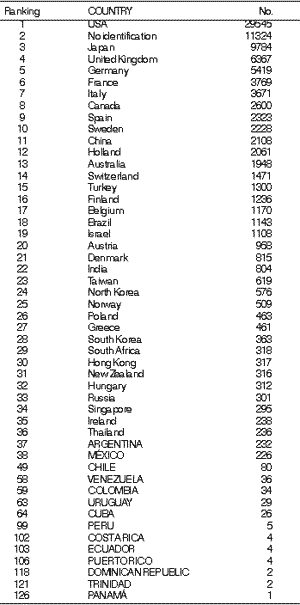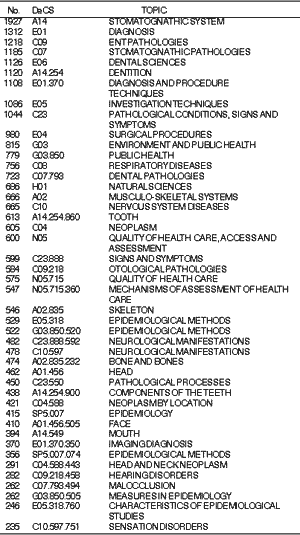

Year: 2003 Vol. 69 Ed. 4 - (1º)
Editorial
Pages: 438 to 439
Otorhinolaryngology: what is it?
Author(s): Henrique Olival Costa
Keywords: -
![]()
It is time we started evaluating the scientific papers submitted for presentation at the national conference of Otorhinolaryngology. An old issue was brought up for discussion: how can we divide the topics by subspecialties grouped under the respective societies of Otology, Rhinology and Laryngology? Upon observing the three names, we can immediately notice that there is a clear thematic distinction in our specialty. This type of intellectual embarrassment is also experienced in the routine of our journal, which has to define who are the colleagues that are going to review the papers submitted for publication. Who would be more suitable to address an article on pharyngotonsillitis: someone who is scientifically experienced in Rhinology or one who works in Laryngology? What about skull base surgery - does it belong to otologists, rhinologists, laryngologists or otorhinolaryngologists? All in all, who is this professional? Our identity difficulties have existed since the moment when the specialty was designed, at the beginning of the 19th century. Apparently, at that time, they started a field of work that seemed to be based more on timely needs and affinity among colleagues than by solid logic basis. We started with Ophthalmology and Otology and moved on to Laryngology and Rhinology. The matter of the fact is we ended up aggregating to other "organ specialists" in the underlying areas and as time went by, we created material and procedures that were similar to support our survival as a specialty. But the times and the world have changed. The ENT specialty that had keep this kind of interest for over one century, started to offer contents that belonged to the organs, but that did not represent the information curriculum provided in specialists' training. ENT physicians work in the areas of electrophysiology, audiology, phoniatrics, head and facial surgery, oncology, neuro-otology, esthetical surgery, endoscopic surgery, pediatrics, functional rehabilitation, dysphagia, stomatology, immunology, and allergology, buco-maxillo-facial surgery, traumatology, and so on and so forth. Who is, after all, the current Otorhinolaryngologist? This question is always present and it is more evident when a reviewer in the area of Otology is not comfortable enough to decide on a study related to labyrinthine disorders. The same applies to a laryngologist that does not feel he or she is apt to decide on a study about hypopharynx cancer. Could we say that the exponential specialization we are currently experiencing , from a scientific perspective, could explain the lack of knowledge in specific fields? Or are we simply not aware of the general training of our specialists, simply because we do not know what Otorhinolaryngology is?
The word now seems to be too small to the dimension of the practice and teaching is equally small. In fact, it follows a winning formula, which was defined over one century ago and that has been through very few changes since then.
The other side of the token is the global uniformity of our area of work. Would a Brazilian Otorhinolaryngologist be the same as a Chinese or Lithuanian one? Even specialists who are not involved in extremely specialized issues may not be the same all over the world. Since training possibilities vary a lot, it is quite evident that what is going to be considered essential for the training in one country, may be different in others. This type of question may be solved by putting together a sample of ENT scientific production and trying to extract the main thematic issues, the most frequent questions, the institutions and authors elected by the public as intellectual gurus and the state-of-the-art studies that try to renew our basic paradigms.
Together with the Regional Medical Library (BIREME) we started a project to define a general overview of our specialty based on theme and author concentrations. Despite the fact that we have barely begun, we have identified in the main databases over 105,000 records of articles, theses, books, chapters and monographs from all over the world between 1997 and 2002. Those five years are being used to generalize the productive activity of ENT all over the world. In order to define what would be extracted, we used the DeCS/MeSH descriptors collection that incorporates words related to practically everything that is studied in Medicine and Health-related sciences and we defined a hierarchical strategy by affinity. That is to say, everything that has the word Otorhinolaryngology is included, but not everything that has the word mouth is included. There are over 50 categories of descriptors used such as surgical techniques, procedures, diagnosis, organs, etc. In order to follow some logics in our process, we selected the Brazilian Journal of ENT and Laryngoscope as the preliminary filter which was used to make the word search. The profile helped us define a minimum profile of what we considered would be understood by most of the academic community as Otorhinolaryngology. Finally, we looked for the content only in journals classified as Otorhinolaryngology journals. Therefore, we had three levels of representation: complete search for descriptors with no filter, filtered search and direct search only in specialized publications (ENT journals).
As preliminary results, we gathered some information that may be of interest to the readers. Brazil, despite the fact that it is lagging behind its scientific potential, is ranked the 18th country in MEDLINE publications (Excerpta Medica and Index Medicus), but ahead of countries that have had greater academic tradition (Table 1). Upon combining the findings of MEDLINE and Lilacs (Latin America and Caribbean Index Medicus), we are ranked 8th in world production. It is also interesting to note that scientific publications are located in the files of Public Health and Epidemiology, Stomatology, nervous and respiratory system, and topics such as otological pathologies and hearing disorders, which are the support for the training of Brazilian specialists, took only lower positions in the thematic distribution (Table 2).
We know that not always reality follows the Academy. We know that not always Academy knows what reality really is. But we still believe that the Academy can indicate the path and help design the future of a Discipline. However, in order to do that, it is necessary to have a plan based on experience, logics and expected results. Otorhinolaryngology has changed, maybe it has changed much more than we thought, probably because our ideas about it are based on the bias of our own clinical practice. The recognition of a well-defined specialty is the first step for the appropriate training and objective-oriented practice.
Table 1. Distribution of countries by registration of scientific papers in ENT on Medline 1997-2002.
Table 2. Distribution of topics by descriptors (DeCS).
All rights reserved - 1933 /
2025
© - Associação Brasileira de Otorrinolaringologia e Cirurgia Cérvico Facial

